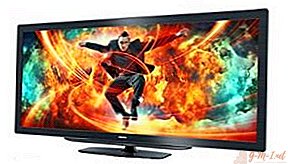TV has long ceased to be something accessible to only a small number of people. The development of modern technology has made TV sets available to everyone. Manufacturers can offer models for every taste and budget.

How to choose an LCD TV for home
Arriving at the store, on the counter you can see a large number of a variety of TV receivers. All of them differ in characteristics, diagonal, type of matrix and other parameters. How to choose the best option that will satisfy all the requirements?
Key selection criteria
To choose the most suitable option, you need to focus on certain parameters.
- Screen size. Choose a suitable diagonal, based on the area of the room in which the TV receiver will be placed. Too many users find that the bigger the TV, the better. This is not true. If the room is small, then the TV receiver should not be large. It can also happen that it simply does not fit into the wall in size or will be much wider than the curbstone. It is worth considering that the human eye cannot cover the whole picture if the distance to it is small.
REFERENCE. The optimal distance should be equal to 4 TV diagonals.
Before buying, it is advisable to measure the distance from the wall and to the place from which you will be viewing.
- Resolution. The number of pixels in the matrix is responsible for this parameter. The larger the number, the clearer the broadcast picture. There are several resolution options: HD, Full HD, Ultra HD - 4 AND 8K. You might think that the higher this value, the better the image will be. But this is not entirely true, since this requires appropriate content with the same resolution. Watching regular TV shows or movies, you simply won’t see the difference between Full HD and 8K. To date, very few films have a resolution of 4 or 8K.
- Matrix. The most popular right now is LED technology. OLED and AMOLED are based on it. The difference between them is that LED cannot transmit true black color, that is, it is inferior in terms of sharpness and contrast. He also has a smaller viewing angle. However, the price of OLED and AMOLED is very high, which makes them less popular. The best option is LED technology.
 Connectors If there is a need to connect additional equipment, headphones and speakers, you need to make sure that the TV has all the necessary connectors, as well as their number. Mandatory are: USB, HDMI, Jack. Connection of additional equipment is carried out by means of these "nests". If you plan to connect a significant amount of equipment, you should make sure that the ports on the TV are enough for these purposes.
Connectors If there is a need to connect additional equipment, headphones and speakers, you need to make sure that the TV has all the necessary connectors, as well as their number. Mandatory are: USB, HDMI, Jack. Connection of additional equipment is carried out by means of these "nests". If you plan to connect a significant amount of equipment, you should make sure that the ports on the TV are enough for these purposes.- Additional functions. Many modern TV models have the Smart TV function. It greatly expands the usual capabilities of the TV receiver, turning it into a full-fledged multimedia center. There are also 3D models. Both of these technologies make TV much more expensive than usual. Therefore, it is worth considering whether they are needed or not. After all, Smart TV cannot replace a computer that is easy to connect to a TV. And it’s 3D for many people their eyes begin to hurt, and watching such films on a TV screen cannot be compared to visiting a movie theater.
Buyer Tips
A few recommendations before buying:
- Amount. It is necessary to clearly determine the amount that can be spent on the purchase.
- Before going to the store, it is worth measuring the area of the room and the place where the TV will be placed in order to find out the optimal size.
- You also need to clearly determine the need for Smart TV, OLED or AMOLED matrix and a resolution of 4 or 8K, since each of these technologies makes the device more expensive.
Having answered all the questions, you can precisely determine the main parameters of the new TV receiver and then the buying process will be quite simple, and the TV will please you for a long time.


 Connectors If there is a need to connect additional equipment, headphones and speakers, you need to make sure that the TV has all the necessary connectors, as well as their number. Mandatory are: USB, HDMI, Jack. Connection of additional equipment is carried out by means of these "nests". If you plan to connect a significant amount of equipment, you should make sure that the ports on the TV are enough for these purposes.
Connectors If there is a need to connect additional equipment, headphones and speakers, you need to make sure that the TV has all the necessary connectors, as well as their number. Mandatory are: USB, HDMI, Jack. Connection of additional equipment is carried out by means of these "nests". If you plan to connect a significant amount of equipment, you should make sure that the ports on the TV are enough for these purposes.
Leave Your Comment